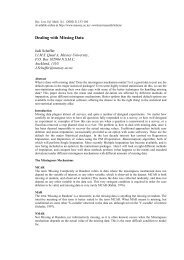Mathematical Modelling of Granulation: Static and Dynamic Liquid ...
Mathematical Modelling of Granulation: Static and Dynamic Liquid ...
Mathematical Modelling of Granulation: Static and Dynamic Liquid ...
Create successful ePaper yourself
Turn your PDF publications into a flip-book with our unique Google optimized e-Paper software.
210 R.L.I.M.S. Vol. 3, April, 2002<br />
h 0<br />
r 0<br />
0.04<br />
0.03<br />
0.02<br />
0.01<br />
0<br />
0 0.1 0.2 0.3<br />
t<br />
0.6<br />
0.59<br />
0.58<br />
0.57<br />
0.56<br />
0 0.1 0.2 0.3<br />
t<br />
dh 0 /dt<br />
dh 0 /dt<br />
0.5<br />
0<br />
−0.5<br />
−1<br />
−1.5<br />
−2<br />
−2.5<br />
0 0.1 0.2 0.3<br />
t<br />
0<br />
−0.5<br />
−1<br />
−1.5<br />
−2<br />
−2.5<br />
−3<br />
0 0.01 0.02<br />
h<br />
0<br />
0.03 0.04<br />
Figure 6: Two solutions from (34)-(37) are plotted for an initial separation <strong>of</strong> h0(0) =0.04 mm. The solid line case<br />
has initial particle velocity ˙ h0(0) = −0.2 mm s −1 ,<strong>and</strong>thedashed line case ˙ h0(0) = −2.2 mm s −1 .<br />
equalising to that <strong>of</strong> external (ambient) pressure. Since no pressure difference exists across the liquid bridge,<br />
the bridge force Fbridge =0(c.f. equation (34)) <strong>and</strong> no further particle movement occurs. Critical values for<br />
the initial separation <strong>and</strong> velocity are a function <strong>of</strong> the parameters for the problem (such as R, m <strong>and</strong> µ).<br />
Two cases occur when the particles are initially moving away, i.e. ˙ h0 > 0. Given this initial condition,<br />
an escape velocity ˙ h ∗ exists such that if ˙ h0(0) < ˙ h ∗ ,theliquid bridge is able to retard the motion <strong>and</strong> the<br />
particles will then come to a stop. If ˙ h0(0) ≥ ˙ h ∗ the particles continue to move apart.<br />
An Example<br />
In figure 6 two examples are shown. The dashed line plot shows two spheres approaching, slowing, <strong>and</strong><br />
colliding. The initial conditions used are h0(0) = 0.04 mm <strong>and</strong> ˙ h0(0) = −2.2 mm s −1 .Thesolid line case<br />
shows approaching spheres which do not collide, using the initial conditions h0(0) = 0.04 mm, ˙ h0(0) =<br />
−0.2 mm s −1 .For both examples, the values <strong>of</strong> the parameters used are R =1mm, r0 =0.7 mm, µ =<br />
10 −3 gmm −1 ,<strong>and</strong> particle mass m =0.1 g.








